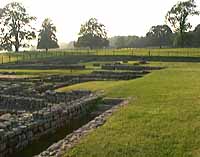 Excavations looking North West Grabungen Blickrichtung Nordwest |
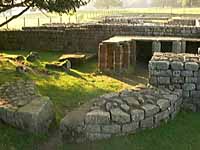 Commandant's House showing the brick pillars of the underfloor hot air heating system. Haus des Kommandanten welches die Steinstäulen für die Warmluft-Bodenheizung zeigt. |
| Chesters Roman Fort / Chesters, römische Festung |
Built just after the wall was completed in AD 123, Chesters is the best preserved Roman Cavalry Fort in Britain.
|
Erbaut kurz nachdem der Wall fertiggestellt war, im Jahr 123, ist Chesters die
best erhaltene römische Kavallerie-Festung in Grossbritannien. |
 Excavations looking North West Grabungen Blickrichtung Nordwest |
 Commandant's House showing the brick pillars of the underfloor hot air heating system. Haus des Kommandanten welches die Steinstäulen für die Warmluft-Bodenheizung zeigt. |
|
Today the site is under the care of English Heritage and is open to the public, as is the small museum of Roman finds which John Clayton built.
|
Heute kümmert sich die Gesellschaft für Englische Kulturgüter
darum, und das Gelände ist öffentlich zugänglich,
wie auch das kleine Museum, welches John Clayton bauen liess. |
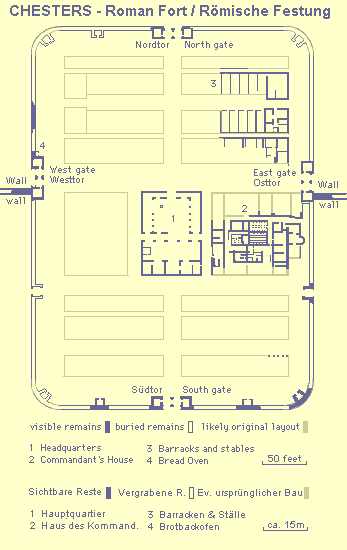
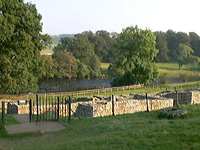 The Baths, with the River Tyne beyond. Die Bäder mit dem Fluss Tyne im Hintergrund. |
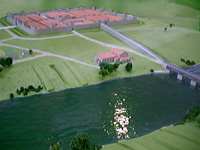 Model (in the Museum) showing the bridge over the river, then the Baths, and the Barracks beyond. Modell (im Museum) zeigt die Brücke über den Fluss, dann die Bäder und die Baracken dahinter. |
Page/Seite 1:
Hadrian
Page/Seite 2:
The Building of the Wall / Der Bau des Hadrianswalls
Page/Seite 3:
Chesters Roman Fort / Chesters, römische Festung
Page/Seite 4:
Roman Objects from Chesters / Römische Fundgegenstände von Chesters
| © About Scotland 1995-2001, Design and Photogr. John Boyd-Brent Übersetzung für Zenger's Kinder - H.Zenger Feb. 2001 | mail exit&links |